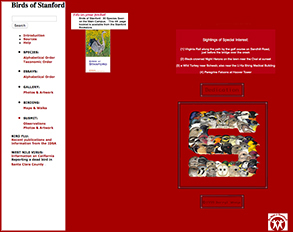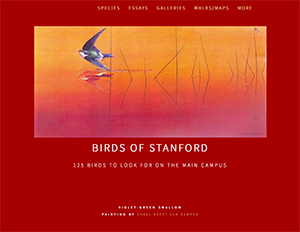 2000 2000 |
The initial 400-page Birds of Stanford website was sponsored by Stanford president emeritus Donald Kennedy, produced for the Stanford Alumni Association and posted on its server in 2000. In 2005 the files were transferred to the Stanford server and in 2012 large species photographs were added. The 2016 update gives the site a new “look” adds small photographs to the species accounts and essays, and redesigns the Gallery adding a new section--Featured Artists--that presents the work of four exceptional artists.
Above all, very special thanks to President emeritus Donald Kennedy for his unwavering support of Stanford's birds and Science Art, and to co-authors Paul R. Ehrlich and David S. Dobkin and Simon and Schuster for The Birder's Handbook material included here.
Very special thanks both to Stanford professor emeritus Tom Grey and Stanford alum Rohan Kamath who generously provided species photographs and to the four featured artists--Barbara Banthiem, Carel Brest van Kempen, Andrew Denman and Terry Miller--who have generously provided examples of their work. The artwork is presented as Science Art (evocative images of nature that include a caption providing a science lens--in our case sometimes a link to one of the essays from The Birder's Handbook). The work of the featured artists can be seen in the Gallery section and on various webpages.
Very special thanks also to Steve Rottenborn for providing the following overview of changes in campus birds since the initial version of The Birds of Stanford website:
“Few obvious changes in bird populations or communities have been noted at Stanford since 2000, but several trends are noteworthy. The Bayward expansion of several species that are regular in the Santa Cruz Mountains and foothills, but that were scarce or absent as breeders in the lowlands as recently as the 1990s, has continued – numbers of Dark-eyed Juncos, Violet-green Swallows, Western Bluebirds, and Oak Titmice continue to increase on the main campus. Bald eagle sightings on Stanford lands have gradually been increasing over the past decade or so as Central California populations increase in general. This trend culminated in the first-ever local nesting, which occurred near Felt Lake in 2016. Peregrine falcon observations around campus have similarly become more frequent as Bay-area breeding populations of this species increase; might we see nesting at Stanford in the near future, perhaps on Hoover Tower where many of our recent observations have occurred?”
Finally very special thanks to Peter Bing and the Stanford Alumni Association for supporting, in part, the initial Birds of Stanford website, and to Tom Grey and Barbara Babcock, Michael Wald, Johanna van de Woestijne, and an anonomous donor for supporting, in part, the 2016 update.
Darryl Wheye, November 2016
(contact: darrylw@stanford.edu or by submitting this form.)
|
 2016 2016 |

